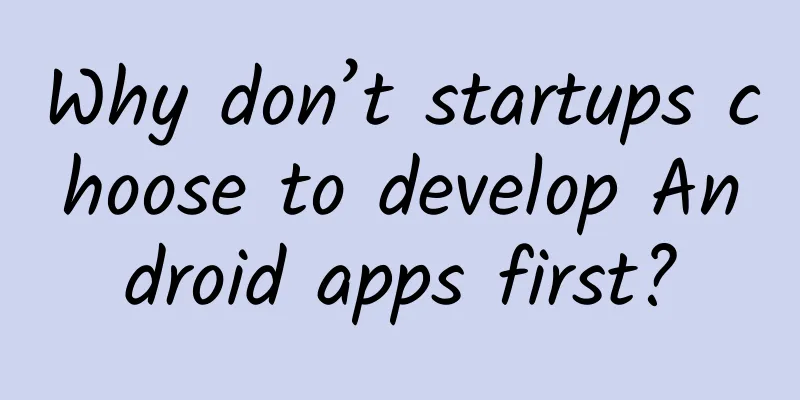Why don’t startups choose to develop Android apps first?

|
In the mobile application field, especially for the consumer market, there is always a debate about whether or when Android platform will become the preferred platform for app development for a wide range of startups. Often people in this debate mistakenly focus on some vanity metrics, such as the huge number of Android phones shipped worldwide, or the leading Android app downloads. However, the reality is that startups are not optimistic about Android as their first choice for app development. Whether in the development practices of startups or in the investment intentions of investors, iOS app development is the first choice for them. If startups want to use Android apps as the vanguard, they will encounter dual obstacles in work structure and financing, which are unlikely to be overcome. No matter how fast Android's market share grows, iOS is still the preferred platform for startups to consider when developing apps. The following facts can help you understand the reason: market share In the United States, iOS still occupies a very high market share (although Android once took the lead, it will regain the lead when Apple releases a new phone). As a large number of innovative mobile application startups go beyond the United States and into the world, Apple's influence on developers as the base camp of the iOS platform cannot be underestimated. In the first quarter of 2015, the number of iOS application downloads in the Chinese market has surpassed that of the United States, and this fundamental will not change in the future. Development difficulty and time cost I have had many exchanges with Android app developers, third-party app stores, mature startup development teams, and investors on iOS and Android platforms. We have come to a simple but cruel reality: the cost of building and publishing an Android app is 3 to 4 times that of an iOS app. This is caused by many reasons: complex development tools, cumbersome APIs, elusive advanced performance, and fragmented development time caused by a large number of QA issues. According to experience, if you transfer the development work that an iOS engineer can complete to the Android platform, you will need two Android engineers to complete it, or spend twice the development time. Financing considerations The amount of effort a startup can put into building and launching an app is strictly limited by the financing process. Today’s startups usually get $800,000 to $1.2 million in seed rounds, and the startups that get the investment not only have to launch a well-polished app, but also show investors the appeal of the product before starting the next round of financing (at least a 5-10x increase in the number of users after the product is launched). This capital limitation and the need for multiple rounds of financing force startups to take a nonlinear development path. If startups want to survive, they must get seed round financing. In seed round financing, investors look at whether you have a strong founding team, broad market prospects and good product ideas; in Series A financing, investors pay more attention to whether your product is attractive, whether it can retain users, and what plans your product has for future profitability. With $1 million to develop an app, a startup can afford a designer, a client developer (iOS or Android), and a backend engineer. Usually the company's technical partner will also serve as the backend engineer, while the business partner will take on the role of product manager. This money is probably enough to support the team to release an app in 18 months and prove that it meets product market demand. Based on the above restrictions, almost no startup company will first choose to develop a product rooted in the Android platform (there are exceptions to everything, such as the founding team like Grand St with a strong Android product DNA). The reason is simple. The founder must prove that the platform product he first chooses to develop has strong user appeal, and then the company can further raise funds to put the product on two different platforms. As for the second choice platform product, it is usually only developed in the A round of financing. That is to say, in the seed round of financing, you choose to develop an iOS App to show the attractiveness of the product to investors, and then successfully get the A round of investment, and then develop an App for the Android platform. (However, even if the company becomes bigger, Windows Phone platform products may not be included in the development schedule. Many large companies have not yet launched Windows Phone products.) Funding restrictions The fact that the money that startups get from seed round financing is only enough to develop a single platform app is well known in the technology circle. Startups prefer to develop iOS apps not only because it is cheap and easy, but also because iOS users have stronger spending power for in-app purchases, and advertisers are more willing to run iOS built-in ads. According to Facebook's previous research on online advertising, advertising on the iOS platform is much more profitable than the Android platform. This is undoubtedly a heavy blow to Android, and it is also extremely bad news for Google. The money and time that startups spend on Android product development is not so easy to recover. Since developing iOS products can better prove the strength of a startup company and is more likely to be favored by institutional investors and successfully reach Series A financing, the apps that can provide the most innovative services will always appear on the iOS platform first. Since it usually takes 12-18 months from seed round financing to Series A financing, this means that the time for innovative applications to appear on the Android platform will lag far behind that of the iOS platform. Of course, there are many innovative startups that have created exquisite apps, but as long as they cannot prove the attractiveness of their products by acquiring users, they will still go bankrupt before the Series A financing. Talent Mobility It is not always smooth sailing for startups to go from seed round to Series A financing. About 80%-90% of companies will quietly die during this period. Another byproduct of startup funding constraints is very interesting: most of these startups will be acquired by large companies in the industry (such as Facebook, Google, Apple, Yahoo, Dropbox, etc.). Since startups usually no longer have their own personnel arrangements after being acquired, large companies can take over a group of very good iOS engineers and product managers who usually have 1-2 years of practical product development experience. There is no doubt that when these people join new companies and new project teams, they will be more inclined to iOS development. When they finally decide to leave the company, they will stick to iOS development as long as there is a good opportunity. This talent flow with iOS development as the main business has formed a virtuous circle of developers in the entrepreneurial community. Although in theory Android also provides a very modern mobile application development platform, the reality is that startups will not choose it as the first choice. Startups can hardly afford to bypass iOS and develop Android products directly, and the gap in product platform selection is still widening. Ignorant people often think that the mobile app market is mature and well developed after referring to the innovative product framework. I disagree. The reality is that software innovation at the app level has been accelerating, and the cost of developing innovative software and hardware has also increased. We all know that it is very difficult to create a valuable mobile app, and when we consider the relationship between development costs and available financing, we will find that iOS is far ahead of Android. Android is far behind in this regard, and for me, the Android platform still has a long way to go to prove its value in terms of usability. |
>>: APIs you must know in Html5
Recommend
How to shoot alcohol brand advertisements?
Recently, Budweiser beer became a hot topic becau...
New ASO optimization trends you must know for APP promotion in 2017!
In the final analysis, ASO is essentially about sa...
[Original] Free promotion of APP with zero budget in the early stage, just do these 17 points!
Preface: I have been working for several years. I...
Apple's new product launch tomorrow: Apple TV launch is unlikely
[September 10 news] In the early morning of Septe...
Can’t come up with notes for popular articles on Xiaohongshu? 5000-word review guide
If a blogger, Xiaohongshu operator, or marketer f...
Wake up! “Humans evolved from monkeys” is wrong!
On April 19, 1882, Charles Darwin, a British natu...
Android 14 Beta 4 update released, Pixel phone/Fold/Tablet can be downloaded
On July 12, Google pushed the Android 14 Beta 4 v...
Is it expensive to rent a small video server?
Is it expensive to rent a small video server? Now...
Using body temperature to generate electricity! Scientists develop a new type of thermal conduction generator that is efficient, durable and stretchable
In 1975, the world's first calculator watch w...
The so-called capital winter is nothing but the collapse of wishful thinking
Last year, we mentioned that winter is coming. Th...
3 new customer acquisition cases, 3 key logics for attracting new customers!
There are many ways to attract new customers , bu...
The "deepest valley" on Earth is 5,382 meters. How did Chinese scientists measure it?
On April 17, 1994, Chinese scientists confirmed f...
Is the LG G3's camera IMX 214?
Which sensor does the LG G3 camera use? Is it IMX ...
360 search advertising promotion, introduction to precise keyword matching method!
Introduction to search promotion matching method ...
Why should we develop mini programs? What are the advantages of WeChat mini programs?
A detailed analysis of the advantages of WeChat M...









